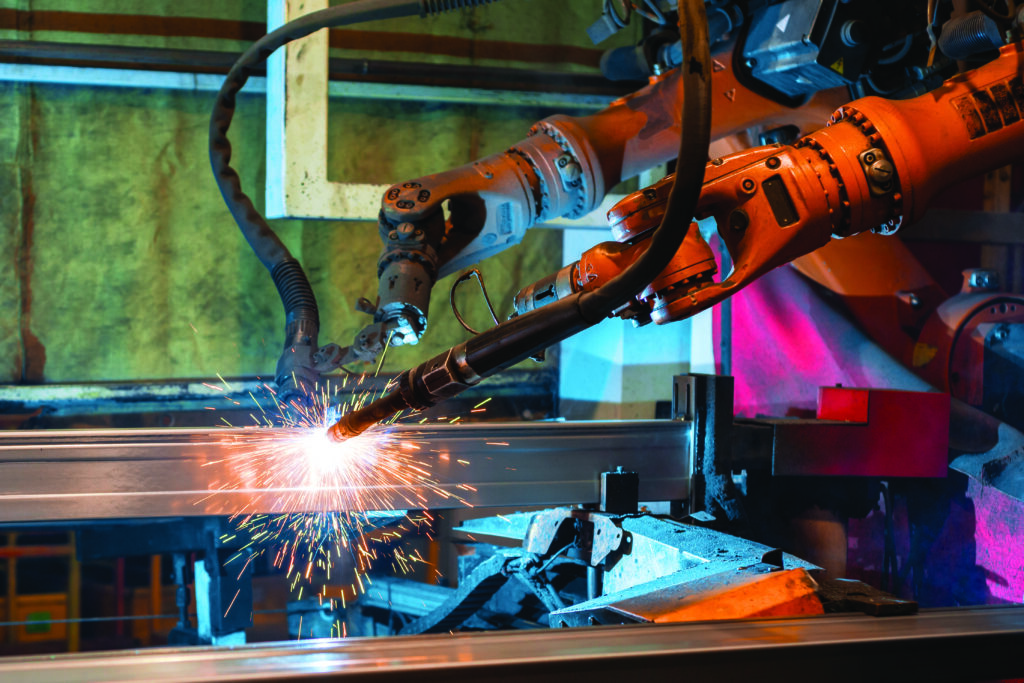Manufacturers are looking to lower cost and increase speed without sacrificing quality. This means getting more done in less time, with less manpower, less scrap and fewer mistakes.
To do this, the manufacturing industry is investing more in automation. Specifically, automating the processes and tasks that machines can do quicker and better than humans and integrating them with a company’s ERP system and other technology.
What once seemed to be the stuff of science fiction – manufacturing plants run by robots – is already a reality. FANUC Corporation of Japan uses a workforce of robots working 24 hours a day, seven days a week to produce up to 23,000 robots a month. Most manufacturers are a long way from being able to automate the majority of their production processes. But as ongoing advances enable machines and humans to get better at talking to each other, more production lines and eventually more production plants will become more and more automated.
If your manufacturing business hasn’t yet jumped on the automation bandwagon, it’s time, and here are the top five reasons why you should.
1.To Reduce Labor Costs
For most manufacturers, labor costs represent the biggest expense and hardest cost to manage (or reduce).
It’s no surprise that companies around the globe have begun using automated machinery and equipment to replace human workers on assembly lines.
For example, automation is already replacing human labor in areas such as picking and moving parts, assembly, inspection and more. Other examples where automation is producing significant reductions in labor costs include:
BOM COMPARE. Reduces expensive engineering time by eliminating the manual comparing of CAD/CAM BOMs against existing BOMs in your ERP system.
RFID. Improves the speed and reliability of employee software logins and inventory tracking.
AUTOMATING PURCHASING. Reduces headcount in the purchasing department while lowering overall purchasing costs.
HUMAN RESOURCES AND PAYROLL INTEGRATIONS. Dramatically reduces HR personnel costs by managing employees and benefits in one system.
2. To Eliminate Waste
To err is to be human. In manufacturing, human error leads to wasted time and resources.
Computers and machines can do many things faster and more accurately than humans – without making mistakes.
ACCURATE INVENTORY. Automating inventory processes such as picking parts and materials and lot tracking can turn accurate inventory from an unfulfilled wish into reality. Automated equipment can also reduce lost or misplaced materials and minimize expiration or spoilage of inventory.
LIGHTS OUT MANUFACTURING. An unused manufacturing plant at night is a wasted asset. Yet, the cost of running 2nd and 3rd shifts can be prohibitive. Automating your manufacturing systems puts your biggest asset to full use without the need for humans. Advantages of “lights out” manufacturing include reduced labor, lighting, and HVAC costs while increasing throughput.
REDUCE SCRAP AND REWORK. Even highly skilled operators can’t match the repeatable accuracy automation produces on routine or less complex processes. Some automated machines can also perform multiple operations, eliminating the time required to move materials from one workcenter to another.
ELIMINATE PAPER. Paper documents slow down the production process by getting lost, misfiled or sent to the wrong person. With automated document management, you can stop shuffling papers and start focusing your human capital on making decisions and creating value. When you digitally send the right data to the right people at the right time, shop floor personnel no longer waste time hunting down routers, drawings, BOMs, POs, or inventory lists.
3. Lightning Fast Turnaround
Times Slow turnaround on jobs can be a deal breaker for many manufacturing customers. Automation lets you process orders faster, reduce setup and production times, and get your product out the door quicker. These are just some of the automations that should already be part of your production process:
INTERFACE. Enables the building of huge BOMs in a few hours rather than days or even weeks.
NESTING INTERFACE. Reduces setup times and material waste by automatically arranging part shapes on bulk pieces of stock material.
EDI. Cuts administrative time and costs for you and your customers with single-entry data transactions.
ECOMMERCE INTEGRATION. Saves time for your customers by allowing them to order and pay directly from your website while automatically sending all job data to your ERP system.
The more you automate customer communications, setup and production processes, the more you can say, “Yes we can” to what were once impossible turnaround times.
4. To Improve Quality and Safety
Rework due to poor quality acts like an anchor on production time and lowers customer satisfaction.
Workers’ comp costs can put large dents in your bottom line. Automating processes in these areas can raise quality ratings while making your workplace safer for employees.
QUALITY. These days, you either produce quality products or you don’t survive. Yet, the cost of achieving the required quality can make it hard to offer competitive prices. Automating quality procedures can help improve quality and reduce its cost at the same time by:
• Simplifying management of rework, rejects and scrap
• Reducing the amount of time to produce and implement engineering change notices
• Controlling every aspect of part revisions and inactivations through your ERP system
• Simplifying the process of qualifying for and maintaining ISO and other certifications
SAFETY. According to OSHA, U.S. manufacturers pay nearly $1 billion per week in workers’ comp due to injuries on the job. Automating production processes can help improve employee safety in three important ways:
• Removing workers from dangerous work procedures
• Enabling faster response to emergencies with real- time monitoring
• Using safety planning software to simplify safety protocol updates and emergency response plans
5. To Future Proof Your Business
In today’s constantly changing manufacturing markets, success often depends on seeing where customers are going and getting there first. Automation improves the ability to forecast trends, see how customer needs will change, and prepare for them from a technology and strategy standpoint so you can get there ahead of the competition.
Automating the data gathering process with Dashboards provides immediate access to accurate, real-time data while reporting or displaying it in any format you choose. This allows you to:
• Identify trends with customers, products and your industry segment
• Analyze your business health by drilling down to any level of detail
• Forecast future customer needs and products/ solutions to meet them
• Make faster, better decisions
Nobody can predict the future with certainty, but automation reduces the odds that the “next big thing” in your market will catch you off guard.
Get Automation Right
Implementing automation is not a quick fix. It’s a continual process where your business evolves with the technology. Automation also requires a large investment in software and machinery. To ensure your capital is spent wisely:
ALIGN YOUR AUTOMATION STRATEGY WITH YOUR BUSINESS AND OPERATIONS STRATEGY. Never implement an automation just for the sake of doing it. Every automation should have a specific purpose and desired outcome that aligns with your long-term business goals.
DEFINE THE PROBLEM AND THE EXPECTED BENEFITS. Before investing in automation, get clear on the problem you need to solve and how the software or equipment provides the best solution. Know what improvements the automation will offer and how it will benefit your business and your customers.
MEASURE THE ROI. It can be easy to overspend on automation software and machinery. To justify the investments, automation should be able to meet current needs while offering the flexibility to adapt to foreseeable future needs.
Don’t Be Late – Automate
As a global leader in ERP software, Global Shop Solutions continually upgrades our software so that manufacturers can integrate their systems with new automation tools and technologies as they are developed.
If you’re struggling to automate key processes in your business, call us today at 800.364.5958 or email us at marketing@gssmail.com.
We’ll show you how to build your products faster, better and for less.










































